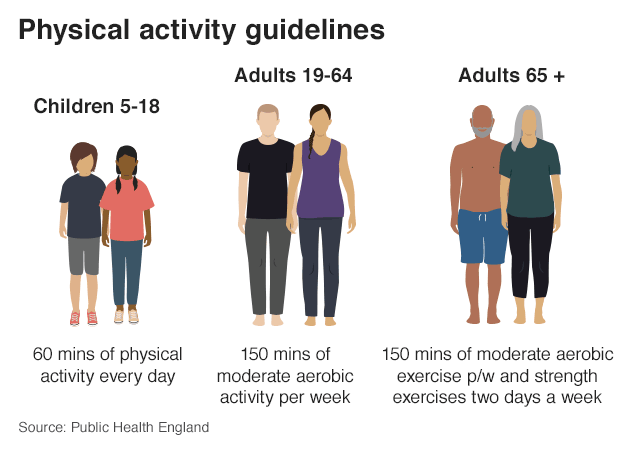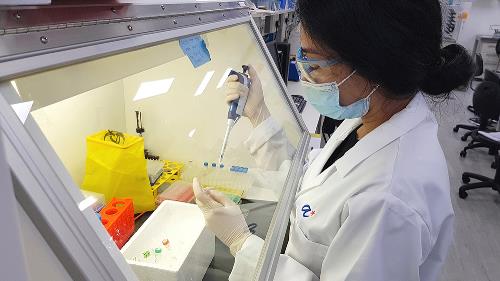Regular physical activity is one of the most important things you can do for your health.Everyone can experience the health benefits of physical activity – age, abilities, ethnicity, shape, or size do not matter.
If you’re not sure about becoming active or boosting your level of physical activity because you’re afraid of getting hurt, the good news is that moderate-intensity aerobic activity, such as brisk walking, is generally safe for most people.
Immediate Benefits
Some benefits of physical activity on brain health[PDF-14.4MB] happen right after a session of moderate-to-vigorous physical activity. Benefits include improved thinking or cognition for children 6 to 13 years of age and reduced short-term feelings of anxiety for adults. Regular physical activity can help keep your thinking, learning, and judgment skills sharp as you age. It can also reduce your risk of depression and anxiety and help you sleep better.
* Increase Energy Levels
* Strengthen heart and lungs
* Lower risk for Disease
* Lower blood pressure nad cholesterol levels
* Relieve stress
* Improve sleep
* Develop stronger muscles
* Help control your weight
Weight Management
Looking to get to or stay at a healthy weight? Both diet and physical activity play a critical role in maintaining a healthy body weight, losing excess body weight, or maintaining successful weight loss. You gain weight when you consume more calories through eating and drinking than the amount of calories you burn, including those burned during physical activity. It’s important to balance calories. When it comes to weight management, people vary greatly in how much physical activity they need. You may need to be more active than others to reach or maintain a healthy weight.

To maintain your weight: Work your way up to 150 minutes a week of moderate-intensity aerobic activity (for example, 30 minutes a day, 5 days a week). Strong scientific evidence shows that physical activity can help you maintain your weight over time. However, the exact amount of physical activity needed to do this is not clear since it varies greatly from person to person. It’s possible that you may need to do more than 150 minutes of moderate-intensity activity a week to maintain your weight.
To lose weight and keep it off: You will need a high amount of physical activity unless you also adjust your diet and reduce the amount of calories you’re eating and drinking. Getting to and staying at a healthy weight requires both regular physical activity and a healthy eating plan.
Reduce Your Health Risk
Cardiovascular Disease
Heart disease and stroke are two of the leading causes of death in the United States. Following the recommendations and getting at least 150 minutes a week of moderate-intensity aerobic activity can put you at a lower risk for these diseases. You can reduce your risk even further with more physical activity. Regular physical activity can also lower your blood pressure and improve your cholesterol levels.
Type 2 Diabetes and Metabolic Syndrome
Regular physical activity can reduce your risk of developing type 2 diabetes and metabolic syndrome. Metabolic syndrome is some combination of too much fat around the waist, high blood pressure, low High Density Lipoproteins (HDL) cholesterol, high triglycerides, or high blood sugar. People start to see benefits at levels of physical activity below the recommended 150 minutes a week. Additional amounts of physical activity seem to lower risk even more.
Some Cancers
Being physically active lowers your risk for developing several commonly occurring cancers. Research shows that adults who participate in greater amounts of physical activity have reduced risks of developing cancers of the:
* Bladder
* Breast
* Colon (proximal and distal)
* Endometrium
* Esophagus (adenocarcinoma)
* Kidney
* Lung
* Stomach (cardia and non-cardia adenocarcinoma)
Improve your quality of life. If you are a cancer survivor, research shows that getting regular physical activity not only helps give you a better quality of life, but also improves your physical fitness.
Strengthen Your Bones and Muscles
As you age, it’s important to protect your bones, joints, and muscles – they support your body and help you move. Keeping bones, joints, and muscles healthy can help ensure that you’re able to do your daily activities and be physically active. Doing aerobic, muscle-strengthening, and bone-strengthening physical activity at a moderately-intense level can slow the loss of bone density that comes with age.
Hip fracture is a serious health condition that can have life-changing negative effects, especially if you’re an older adult. Physically active people have a lower risk of hip fracture than inactive people.

Among older adults, physical activity also reduces the risk of falling and injuries from falls. Physical activity programs that include more than one type of physical activity are most successful at reducing falls and fall-related injuries. Different types of physical activity include aerobic, muscle strengthening, and balance physical activities. Also, weight bearing activities such as running, brisk walking, jumping jacks and strength training produce a force on the bones. These activities that can help promote bone growth and bone strength and reduce the risk of fall-related injuries and fractures.
Regular physical activity helps with arthritis and other rheumatic conditions affecting the joints. Doing 150 minutes a week of moderate-intensity aerobic physical activity, if able, plus muscle-strengthening activity improves your ability to manage pain and do everyday tasks and improves quality of life.
Build strong, healthy muscles. Muscle-strengthening activities like lifting weights can help you increase or maintain your muscle mass and strength. This is important for older adults who experience reduced muscle mass and muscle strength with aging. Slowly increasing the amount of weight and number of repetitions you do as part of muscle strengthening activities will give you even more benefits, no matter your age.
Improve Your Ability to do Daily Activities and Prevent Falls
A functional limitation is a loss of the ability to do everyday activities such as climbing stairs, grocery shopping, or playing with your grandchildren.
How does this relate to physical activity? If you’re a physically active middle-aged or older adult, you have a lower risk of functional limitations than people who are inactive.
Improve physical function and decrease the risk of falls. For older adults, multicomponent physical activity is important to improve physical function and decrease the risk of falls or injury from a fall.
Multicomponent physical activity is physical activity that includes more than one type of physical activity, such as aerobic, muscle strengthening, and balance training. Multicomponent physical activity can be done at home or in a community setting as part of a structured program.
Increase Your Chances of Living Longer
Science shows that physical activity can reduce your risk of dying early from leading causes of death, like heart disease and some cancers. This is remarkable in two ways:
- Only a few lifestyle choices have as large an impact on your health as physical activity. People who are physically active for about 150 minutes a week have a 33% lower risk of all-cause mortality than those who are physically inactive.
- You don’t have to do high amounts of activity or vigorous-intensity activity to reduce your risk of premature death. Benefits start to accumulate with any amount of moderate- or vigorous-intensity physical activity.
Check with your doctor first before starting any exercise program, Especially if you have a chronic health condition.



